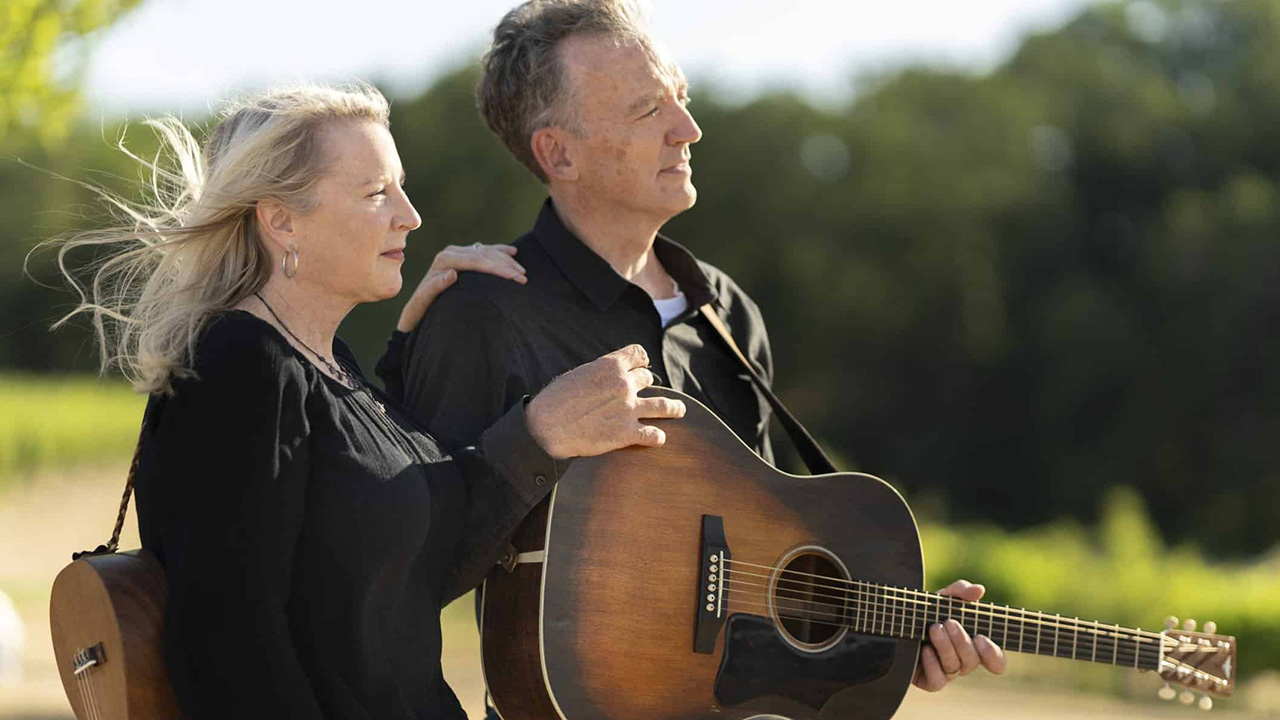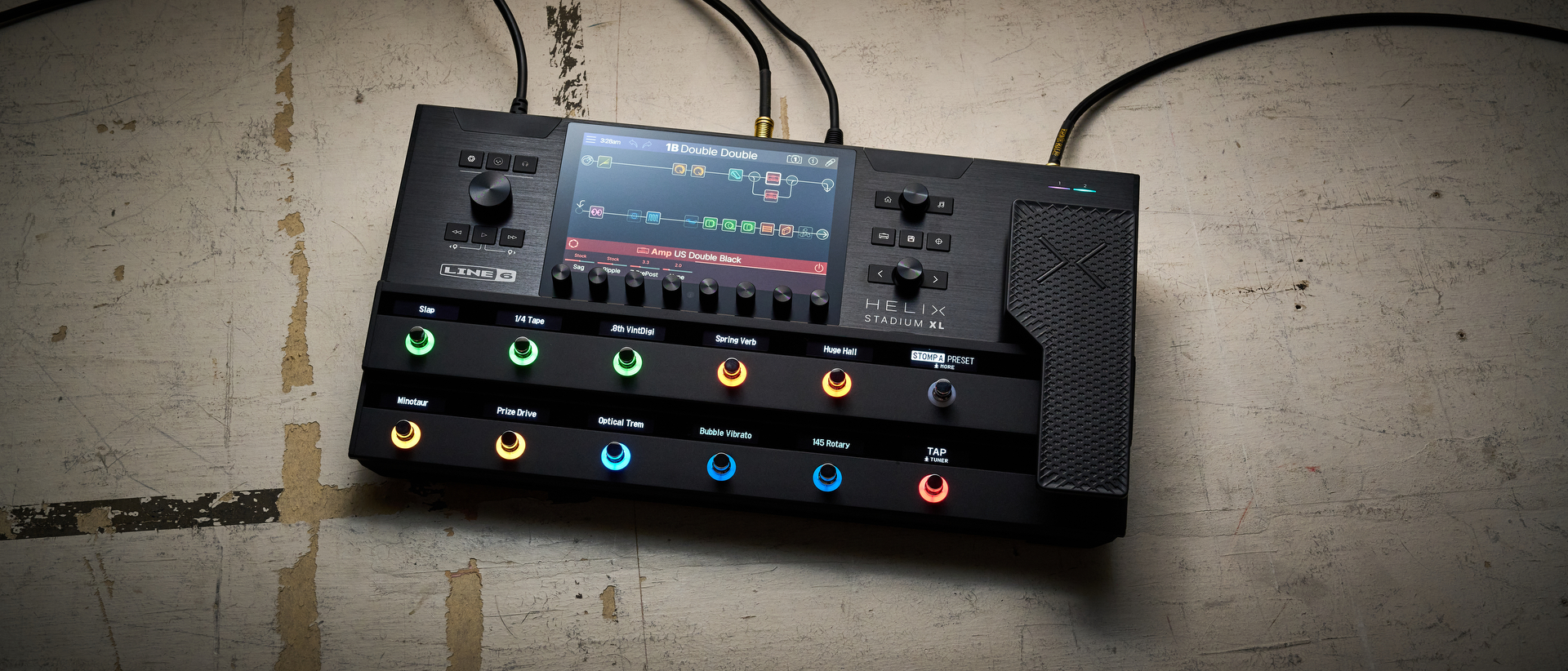“I have these big meat hooks, so I can pick up a lot of wonderful guitars, but if I played them for two hours, I’d be cramping. I only have one guitar that I didn’t build”: Meet bluegrass-shredding luthier Dan Wetzel
The True North guitarist learned to pick by listening to vinyl and not seeing his heroes’ hands – then turned to building instruments because of the size of his own

It’s not unusual for musicians to own custom guitars, built to their specifications, which they had a part in designing. Personally building their instruments from the ground up is not as common – but for Kristen Grainger and Dan Wetzel, it makes sense.
While performing as a duo or with their band, True North, the two play original songs on original instruments that Wetzel builds in his home workshop. Each piece, like their songs, is unique – carefully crafted and labored over, telling its own story while perfectly woven into the fabric of the big picture.
True North is comprised of four major-league musicians. Lead vocalist Kristen Grainger, the band’s primary songwriter, won top honors at the Telluride Bluegrass Festival, MerleFest, and USA Songwriting Contest. She plays a tenor ukulele built by Wetzel.
Martin Stevens plays mandolin, octave mandolin, fiddle, and adds harmony vocals. Josh Adkins plays upright bass and adds harmony vocals. Wetzel, vocalist and luthier, plays guitar, banjo, resonator slide guitar, and mandola – all his creations, and all featured on their latest album, Fear Of Falling Stars.
The band is based in Portland, Oregon, but Wetzel’s journey began in Sandpoint, Idaho. His father’s job moved the family to various cities around the Pacific Northwest, eventually landing them in Marysville, Washington, where Wetzel remained until graduating high school.
He studied music at Washington State University before moving to Bozeman, Montana, where he found his calling. He worked at the Flatiron Mandolin Company and spent time at the Back Porch Pickin’ Parlor.
“It was a great bluegrass store that had jams, lessons, a lot of teachers and players,” he says. “Everybody would migrate there in the afternoons – you’d run into somebody and you could pick with them. I was around people who were playing all-acoustic music, and it was very easy to get bitten and decide, ‘This is what I want to do.’”
All the latest guitar news, interviews, lessons, reviews, deals and more, direct to your inbox!
You learned to play by moving the needle over vinyl. Were there advantages to that method?
“For me, there was something to be said for the old-school way. I couldn’t see, ‘Where does he have his hand? What fret is he on?’ It forced my brain to listen to a phrase, memorize it, and figure out where it is on the guitar.
“And that’s just to get the left hand down. The right hand, that’s still taking time to perfect 40 years later! I surrounded myself with vinyl albums of flatpicking and tried to learn how to do it.”
Which albums did you surround yourself with?
“I first discovered flatpicking on a friend’s Dan Crary album, Lady’s Fancy. I’d never heard anybody play guitar like that. I bought that album and Norman Blake’s Whiskey Before Breakfast. Then I discovered Tony Rice, Doc Watson, and the David Grisman Quintet. That was a whole other level. All I could do was appreciate it!
“But I thought, ‘If I keep learning these Doc Watson and Norman Blake tunes, eventually I’ll get my right hand to work.’ I discovered tablature and that opened up a new world. So it was always a progression of what I could do to get better.
“There were some local pickers that were just fantastic, and I’d ask, ‘How do you play so clean?’ The answer was always, ‘You just do it and do it and do it. You put in your time and just play the guitar.’”
What do you do now to get better?
“It’s still the same mantra: I just play. Luckily, it’s never felt like, ‘Ugh, I’ve got to practice.’ It’s, ‘I can’t wait to sit down, pick up a guitar and noodle around.’ I try to figure out new ways to play songs.
The guitar I built that I play most is all about string tension and how I can dig into it and not have it get nasal
“When I met and married Kristen, she started writing fantastic songs. They weren’t bluegrass – this wasn’t how many 16th notes you can fit into a measure. It was, ‘Here’s a wonderful story.’ My job became, ‘How can I arrange this song to hold up the story that she’s singing?’”
What does your practice consist of?
“It’s fingerpicking and flatpicking, but not in the same way. A lot of it is creating feels, grooves, crosspicking patterns, or fingerpicking patterns that go great with a song we’re working on.
“I also do a lot of guitar aerobics – playing fiddle tunes and things like that. There’s fiddle tunes I’ve played for 30 years that I still play differently every time, just some little, ‘I wonder if this would fit in here.’ You’re doing it on the fly, as fast as you can think, and, ‘Wait a minute, that was cool!’ back up, try it again, and incorporate that into a lead.”
As a luthier, are you more discerning (a polite way to say “difficult to please”) when looking at instruments built by manufacturers?
“Absolutely, and ‘difficult to please’ is it. I have very large hands. A lot of that’s genetic – my height and size – but a lot of it is working with my hands and playing a lot of sports for a good part of my life. I have these big meat hooks, so I can pick up a lot of wonderful guitars – but if I played them for two hours, I’d be cramping and not enjoying it.
“When I build instruments for myself, they’re often larger necks. Also, when I really started to figure out how to flatpick, especially in an acoustic band where the guitar can get buried, I had to learn how to get tone and volume at the same time. A lot of that is how much you can dig in without the guitar washing out.
“The guitar I built that I play most is all about string tension and how I can dig into it and not have it get nasal. Of course, being Kristen’s guitar player, a huge part of what I’m shooting for when I build something to keep is how it’s going to affect her vocals.”
How many in your collection are your builds, and what are your preferred tonewoods?
“I only have one guitar that I didn’t build. It’s my very first Martin, a 1978 Herringbone D-28 that I bought new for $800. It’s the guitar I played when I toured solo, and I’ve kept it through the years.
“For a long time when I was in bluegrass bands, I was a mandolin player, which I loved because it cuts through. When I went back to guitar, it became about what kind of guitar will cut through if I’m going to play a solo.
I’ve dealt with myrtlewood, koa, walnut, and different things, but I love the sound of mahogany – if you get it right
“I migrated toward mahogany back and sides because it didn’t seem as muddy as rosewood. Rosewood guitars are great for rhythm, but I preferred mahogany, as long as it was a big enough body cavity to not sound thin.
“The collection I have now, I have five or six guitars that are different sizes and shapes, and most are mahogany. One is cocobolo, which is a rosewood-type guitar, and one is Claro walnut, which is a cool sound.
“I have a resonator guitar that’s all mahogany, top and back and sides, but the rest are mahogany back and sides with Sitka spruce tops. I have some other instruments that I built – an acoustic bass guitar, a banjo and a ukulele. I’ve built Kristen a couple of ukuleles and a guitar.
“But I love mahogany. In fact, I just bought a set from The Tree. It’s gorgeous quilted mahogany and I’m looking forward to working with it. I’ve dealt with myrtlewood, koa, walnut, and different things, but I love the sound of mahogany – if you get it right.”
Which guitars did you use on Fear Of Falling Stars?
“The first guitar I completed is the one I keep playing. It’s a Gibson J-45 body size and style. It has a longer scale length, a neck that fits my hand, and it sounds great. Kristen calls it ‘Fat Ass’ because it has a big bottom end, musically and physically. It’s become my signature sound.
“I used the Claro walnut guitar, which is an oversized Martin OM shape, and it sounds great in open D tuning. There’s something about it that really comes alive. It’s on the first track, Don’t Take Me Back.
“On What Might Have Been I played the ‘Fat Ass’ guitar and resonator because I wanted to do some slide behind that. I played a banjo that I built on a couple of tracks. So I guess four of my instruments in total.”
I love Kristen’s description of True North as “poets that pick.”When you write music with a message, are you sometimes concerned that the depth may become background, or do you have faith in your fanbase to continue listening with intent?
We send people away with something that moves them, the story – not ‘Look how fast I can play!’
“That is the question. We feel really lucky that what you just described is what’s most often true. We’re a ‘sit down in a seat that’s screwed to the floor and really take something in’ band.
“When we stand at the merch table during the break or after a show, the first thing people talk about is that, one, they could hear every word we delivered; and, two, the lyrics are moving.
“It gives us a lot of pride that we send people away with something that moves them, the story – not ‘Look how fast I can play!’ It’s comforting to have people say that to us over and over, and to have reviewers write that this isn’t shallow surface picking.
“This is music with a message. We have things to say, and this is the best way we’ve figured how out to say them.”
- Fear Of Falling Stars is out now.
Alison Richter is a seasoned journalist who interviews musicians, producers, engineers, and other industry professionals, and covers mental health issues for GuitarWorld.com. Writing credits include a wide range of publications, including GuitarWorld.com, MusicRadar.com, Bass Player, TNAG Connoisseur, Reverb, Music Industry News, Acoustic, Drummer, Guitar.com, Gearphoria, She Shreds, Guitar Girl, and Collectible Guitar.





